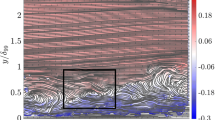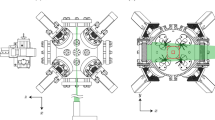Abstract
Particle image velocimetry (PIV) measurements of Mach 3 turbulent boundary layers (TBL) have been performed under low Reynolds number conditions, \(Re_\tau =200{-}1000\), typical of direct numerical simulations (DNS). Three reservoir pressures and three measurement locations create an overlap in parameter space at one research facility. This allows us to assess the effects of Reynolds number, particle response and boundary layer thickness separate from facility specific experimental apparatus or methods. The Morkovin-scaled streamwise fluctuating velocity profiles agree well with published experimental and numerical data and show a small standard deviation among the nine test conditions. The wall-normal fluctuating velocity profiles show larger variations which appears to be due to particle lag. Prior to the current study, no detailed experimental study characterizing the effect of Stokes number on attenuating wall-normal fluctuating velocities has been performed. A linear variation is found between the Stokes number (St) and the relative error in wall-normal fluctuating velocity magnitude (compared to hot wire anemometry data from Klebanoff, Characteristics of Turbulence in a Boundary Layer with Zero Pressure Gradient. Tech. Rep. NACA-TR-1247, National Advisory Committee for Aeronautics, Springfield, Virginia, 1955). The relative error ranges from about 10% for \(St=0.26\) to over 50% for \(St=1.06\). Particle lag and spatial resolution are shown to act as low-pass filters on the fluctuating velocity power spectral densities which limit the measurable energy content. The wall-normal component appears more susceptible to these effects due to the flatter spectrum profile which indicates that there is additional energy at higher wave numbers not measured by PIV. The upstream inclination and spatial correlation extent of coherent turbulent structures agree well with published data including those using krypton tagging velocimetry (KTV) performed at the same facility.


















Similar content being viewed by others
References
Adrian RJ, Westerweel J (2011) Particle image velocimetry. Cambridge University Press, New York
America Litron Lasers North (2010) Lasers for PIV applications. Bozeman, Montana
Benedict LH, Gould RD (1996) Towards better uncertainty estimates for turbulence statistics. Exp Fluids 22:129–136
Brooks J, Gupta AK, Helm C, Martin MP, Smith M, Marineau E (2017) Mach 10 PIV Flow Field Measurements of a Turbulent Boundary Layer and Shock Turbulent Boundary Layer Interaction. In: 33rd AIAA Aerodynamic Measurement Technology and Ground Testing Conference. AIAA 2017-3325, Denver, Colorado, USA. https://doi.org/10.2514/6.2017-3325
Brooks JM, Gupta AK, Smith MS, Marineau EC (2014) Development of Non-Intrusive Velocity Measurement Capabilities at AEDC Tunnel 9. In: 52nd AIAA Aerospace Sciences Meeting. AIAA 2014-1239, National Harbor, Maryland, USA. https://doi.org/10.2514/6.2014-1239
Brooks JM, Gupta AK, Smith MS, Marineau EC (2015) Development of particle image velocimetry in a Mach 2.7 wind tunnel at AEDC white oak. In: 53rd Aerospace Sciences Meeting. AIAA 2015-1915, Kissimmee, Florida, USA. https://doi.org/10.2514/6.2015-1915
Brooks JM, Gupta AK, Smith MS, Marineau EC (2016) PIV measurements of mach 2.7 turbulent boundary layer with varying Reynolds numbers. In: 54th AIAA Aerospace Sciences Meeting. AIAA 2016-1147, San Diego, California, USA. https://doi.org/10.2514/6.2016-1147
Cadel DR, Shin D, Lowe KT (2016) A hybrid technique for laser flare reduction. In: 54th AIAA Aerospace Sciences Meeting. AIAA 2016-0788, San Diego, California, USA. https://doi.org/10.2514/6.2016-0788
Coleman HW, Steele WG (2009) Experimentation, validation, and uncertainty analysis for engineers. Wiley, Hoboken
Coles D (1956) The law of the wake in the turbulent boundary layer. J Fluid Mech 1:191–226
Devenport W, Schetz J (1998) Boundary layer codes for students in Java. In: 1998 ASME Fluids Engineering Division Summer Meeting. FEDSM98-5139, Washington, DC, USA
Devenport WJ, Schetz JA, Wang Y (1999) Heat transfer codes for students in Java. In: 5th ASME/JSME Thermal Engineering Joint Conference. AJTE99-6229, San Diego, California, USA
Duan L, Beekman I, Martin M (2011) Direct numerical simulation of hypersonic turbulent boundary layers. Part 3. Effect of Mach number. J Fluid Mech 672:245–267. https://doi.org/10.1017/S0022112010005902
Ekoto IW, Bowersox RDW, Goss L (2007) Mach 10 PIV flow field measurements of a turbulent boundary layer and shock turbulent boundary layer interaction. In: 45th AIAA Aerospace Sciences Meeting and Exhibit. AIAA 2007-1137, Reno, Nevada, USA. https://doi.org/10.2514/6.2007-1137
Elena M, LaCharme JP (1988) Experimental study of a supersonic turbulent boundary layer using a laser Doppler anemometer. J Theor Appl Mech 7(2):175–190
Fernholz HH, Finley PJ (1980) A critical commentary on mean flow data for two-dimensional compressible turbulent boundary layers. Tech. Rep. AGARDograph No. 253, Advisory Group for Aerospace Research and Development, Neuilly sur Seine (1980)
Hopkins EJ, Inouye M (1971) An Evaluation of Theories for Predicting Turbulent Skin Friction and Heat Transfer on Flat Plates at Supersonic and Hypersonic Mach Numbers. AIAA J 9(6):993–1003
Integrated Design Tools (2016) OS10-V3-4K Specification Sheet. Tallahassee, Florida, USA. https://idtvision.com/support/specifications-sheets/?idt_id=OS10-V3-4K
Kistler AL (1959) Fluctuation measurements in a supersonic turbulent boundary layer. Phys Fluids 2(3):290–296. https://doi.org/10.1063/1.1705925
Klebanoff PS (1955) Characteristics of turbulence in a boundary layer with zero pressure gradient. Tech. Rep. NACA-TR-1247, National Advisory Committee for Aeronautics, Springfield, Virginia, USA
Lapsa AP, Dahm WJA (2011) Stereo particle image velocimetry of nonequilibrium turbulence relaxation in a supersonic boundary layer. Exp Fluids 50(1):89–108. https://doi.org/10.1007/s00348-010-0897-x
Lewis JE, Gran RL, Kubota T (1972) An experiment on the adiabatic compressible turbulent boundary layer in adverse and favourable pressure gradients. J Fluid Mech 51(4):657–672
Loth E, Introduction I (2008) Compressibility and rarefaction effects on drag of a spherical particle. AIAA J 46(9):2219–2228. https://doi.org/10.2514/1.28943
Lowe KT, Byun G, Simpson RL (2014) supersonic turbulent boundary layer statistics. In: 52nd AIAA Aerospace Sciences Meeting. AIAA 2014-0233, National Harbor, Maryland, USA
Martin MP (2007) Direct numerical simulation of hypersonic turbulent boundary layers. Part 1. Initialization and comparison with experiments. J Fluid Mech 570:347–364. https://doi.org/10.1017/jfm.2011.252
Mei R (1996) Velocity fidelity of flow tracer particles. Exp Fluids 22:1–13
Millikan CBA (1938) A critical discussion of turbulent flows in channels and circular tubes. In: Proceedings of the Fifth International Congress of Applied Mechanics, pp 386–392
Morkovin MV (1962) Effects of compressibility on turbulent flows. In: Favre AJ (ed) Mecanique de la Turbulence. Centre National de la Recherche Scientifique (CNRS), pp 367–380
Mustafa MA, Hunt MB, Parziale NJ, Smith MS, Marineau EC (2017) Krypton Tagging Velocimetry ( KTV ) Investigation of Shock-Wave/Turbulent Boundary-Layer Interaction. In: 55th AIAA Aerospace Sciences Meeting, January. AIAA 2017-0025, Grapevine, Texas, USA. https://doi.org/10.2514/6.2017-0025
Peltier S, Humble RA, Bowersox RDW (2012) PIV of a Mach 5 Turbulent Boundary Layer over Diamond Roughness Elements. In: 42nd AIAA Fluid Dynamics Conference and Exhibit. AIAA 2012-3061, New Orleans, Louisiana, USA. https://doi.org/10.2514/6.2012-3061
Perry AE, Chong MS (1982) On the mechanism of wall turbulence. J Fluid Mech 119:173–217. https://doi.org/10.1017/s0022112082001311
Piponniau S (2009) Instationnarit es dans les d ecollements compressibles: cas des couches limites soumises ‘ a ondes de choc. Universit e de Provence-Aix-Marseille, Docteur
Pirozzoli S, Bernardini M (2011) Turbulence in supersonic boundary layers at moderate Reynolds number. J Fluid Mech 688(2011):120–168. https://doi.org/10.1017/jfm.2011.368
Pirozzoli S, Bernardini M (2013) Probing high-Reynolds-number effects in numerical boundary layers. Phys Fluids 021704(25):1–7. https://doi.org/10.1063/1.4792164
Ragni D, Schrijer F, Oudheusden BWV, Scarano F (2011) Particle tracer response across shocks measured by PIV. Exp Fluids. https://doi.org/10.1007/s00348-010-0892-2
Samimy K, Lele SK (1991) Motion of particles with inertia in a compressible. Phys Fluids A 3(8):1915–1923. https://doi.org/10.1063/1.857921
Smits AJ, Dussage JP (2006) Turbulent Shear Layers in Supersonic Flow, 2nd edn. Springer, New York
Smits AJ, Hayakawa K, Muck KC (1983) Constant temperature hot-wire anemometer practice in supersonic flows- Part l: the normal wire. Exp Fluids 1(2):83–92. https://doi.org/10.1007/BF00266260
Taylor GI (1937) The spectrum of turbulence. Proc R Soc Lond A 164(919):476–490
Tichenor NR, Humble RA, Bowersox RDW (2011) Influence of Favorable Pressure Gradients on a Mach 5 . 0 Turbulent Boundary Layer. In: 49th AIAA Aerospace Sciences Meeting including the New Horizons Forum and Aerospace Exposition. AIAA 2011-0748, Orlando, Florida, USA
Tichenor NR, Humble RA, Bowersox RDW (2012) Reynolds Stresses in a Hypersonic Boundary Layer with Streamline Curvature—Driven Favorable Pressure Gradients. In: 42nd AIAA Fluid Dynamics Conference and Exhibit. AIAA 2012-3059, New Orleans, Louisiana, USA
Townsend AA (1951) The structure of the turbulent boundary layer. Math Proc Cambridge Philos Soc 47:375–395. https://doi.org/10.1017/s0305004100026724
van Driest ER (1951) Turbulent boundary layer in compressible fluids. J Aeronaut Sci 18(3):145–160
Walz A (1969) Boundary layers of flow and temperature. MIT Press, Cambridge
Williams OJH (2014) Density effects on turbulent boundary layer structure: from the atmosphere to hypersonic flow. Doctoral dissertation, Princeton University
Williams OJH, Nguyen T, Schreyer AM, Smits AJ (2015) Particle response analysis for particle image velocimetry in supersonic flows. Phys Fluids 27:076101. https://doi.org/10.1063/1.4922865
Williams OJH, Sahoo D, Baumgartner M, Smits AJ (2018) Experiments on the structure and scaling of hypersonic turbulent boundary layers. J Fluid Mech 834:237–270
Zahradka D, Parziale NJ, Smith MS, Marineau EC (2016) Krypton tagging velocimetry in a turbulent Mach 2.7 boundary layer. Exp Fluids 57(5):1–14. https://doi.org/10.1007/s00348-016-2148-2
Author information
Authors and Affiliations
Corresponding author
Additional information
Publisher’s Note
Springer Nature remains neutral with regard to jurisdictional claims in published maps and institutional affiliations.
Rights and permissions
About this article
Cite this article
Brooks, J.M., Gupta, A.K., Smith, M.S. et al. Particle image velocimetry measurements of Mach 3 turbulent boundary layers at low Reynolds numbers. Exp Fluids 59, 83 (2018). https://doi.org/10.1007/s00348-018-2536-x
Received:
Revised:
Accepted:
Published:
DOI: https://doi.org/10.1007/s00348-018-2536-x




